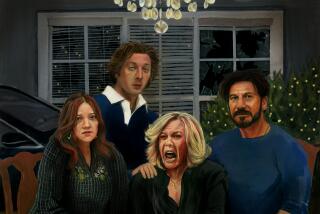Crises of a Cardboard Couple : VIOLENCE, <i> By Richard Bausch (Houghton Mifflin/Seymour Lawrence: $22.50; 293 pp.)</i>
- Share via
A young couple, struggling with finances and the prospect of a first baby, drive from Virginia to Chicago to visit the husband’s mother. Randomly caught in a convenience-store shootout, the husband witnesses four killings, is held briefly hostage, and escapes. The experience arouses his own suppressed memories of the violence inflicted upon him as a child, and all but destroys him.
Richard Bausch’s new novel is in part a portrait of the small increments of pain in a young marriage in trouble. In part, it is the dramatization of a confrontation in which the protagonist tests himself under the kind of atrocious violence that makes newspaper front pages. Mostly, it is a psychological study of the festering disablement that childhood abuse can inflict.
Bausch writes very well about the surfaces and appearance of things; about how people deal with each other, how they fail to, how they feel when they are dealing or failing. The book’s opening is splendid; we see what a long winter drive feels like when the travelers are on edge about their lives and themselves. Carol and Charles Connally are mostly silent or make small talk; isolated together in their car, it is as if they refracted the wintry Midwestern emptiness outside.
He is in graduate school, but uncertain and unfocused. She works as a dental hygienist to support them and get him through; he feels the pressure of her hopes; he is unsure if he is up to their joint expectations. Her pregnancy terrifies him but he has said nothing, and the unspoken fear deepens the silence.
Bausch does this very well. The tension finds part of its voice when they stop at a cheap motel. Deeper things are at stake when Carol remarks on the smell of gas, the patched sheet, the broken TV, and when Charles reminds her they can’t afford more. The muted quarrel contends with their longing to have things be all right. Offense and conciliation shuttle back and forth, always a little out of phase.
The same fretful rhythm is at work when they are with Tina, Charles’ mother. She and Carol get along fine, but there is unspoken darkness between her and her son. She failed to stop his father from savagely maltreating him as a child; when she did take him away, it was to leave him with his grandmother. These things are not spoken; Tina is flighty and vaguely placatory; Charles is sullen or twitchy.
All this is told in precise detail, yet after a while we bog down. Bausch describes his people without really creating them. He assigns plights, he plots emotions and how they work, but he assigns and plots them with generic characters who are called Charles and Carol and Tina. He might be casting an intelligent sitcom or, when Charles’ childhood bursts out later and he confronts himself and his mother, it is as if we were reading of C and C and T in a well-written book of popular psychology.
The characterlessness of the characters mars the second part as well. Charles, unable to sleep, wanders into a convenience store late at night. Gunmen break in and herd the customers and proprietor into a freezer area. The brutal leader pulls out one of them, a nurse, and kills her. Another customer, who is a plainclothesman, shoots and kills the killer, but then is shot and killed by the killer’s nervous sidekick, who then kills another customer and tries to use Charles as a shield to escape. Charles breaks free and the gunman is captured.
It is efficiently described and paced, but the action lacks individuality or any touch that would distinguish it from all the similar situations dramatized in film and on television. And the customers--the nurse and the plainclothesman, who are black, the Chinese proprietor, an old white man--seem distributed rather than written.
The book’s third part tells of Charles’ crack-up. He avoids talking about his ordeal, and rejects the “hero” label the media and his family try to pin on him. He drops out of his classes without telling Carol; there is agonizing silence between them.
It seems like the normal battle fatigue that can follow such an incident, but there is more. We get Charles remembering his brutal father, confronting his mother and, finally, armed with a pistol, trying to get at the surviving gunman. He glimpses him through the fence of the prison yard, and suddenly he realizes that he is seeing one more helpless link in the chain of violence. Charles had almost become such a link himself, but in the last few pages he begins a tentative recovery.
But despite the plausibility with which most of these things are set out, it remains hard to care. Even the varied and convincing silences between Charles and Carol fail to mean much. Silence is a workable dramatic device when we feel there is a character speaking to us through it. We wait for the silence to be broken. But when Charles and Carol are silent, they disappear, and there is little sense that they were ever there, except as devices to get the story told, and the theme worked out.
More to Read
Sign up for our Book Club newsletter
Get the latest news, events and more from the Los Angeles Times Book Club, and help us get L.A. reading and talking.
You may occasionally receive promotional content from the Los Angeles Times.







